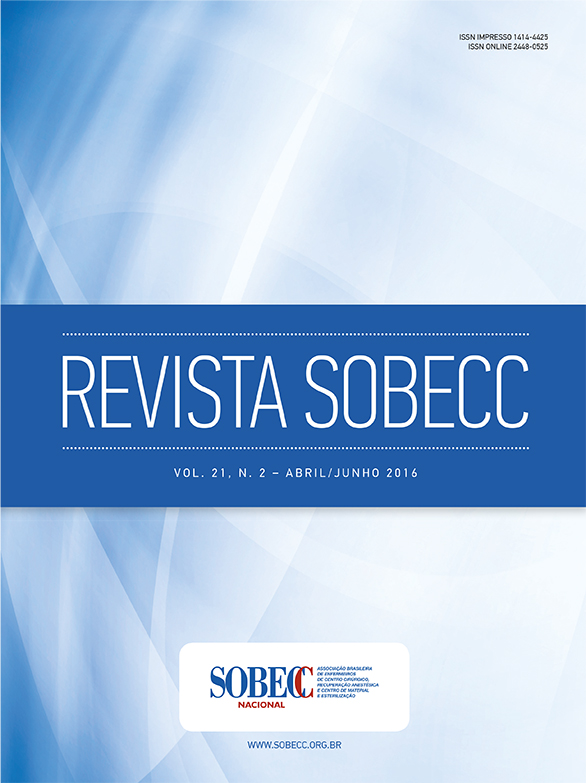Deployment and operation of a hybrid operating room in a private hospital in São Paulo.
DOI:
https://doi.org/10.5327/Z1414-4425201600020006Keywords:
Minimally invasive surgical procedures. Intraoperative period. Operating rooms. Technology, high-cost.Abstract
Objective: To report the experience of the deployment of a hybrid operating room and to identify the demands of its operation in a private hospital in São Paulo, Brazil. Method: Retrospective study, with experience report. The database of the surgical center was used to collect information, which was recorded in an instrument (sample characterization, information on the operation, and use of the hybrid operating room). Results: The hybrid operating room was used for the care of 166 patients in 15 months; most were men (109; 65.7%), aged 71–80 years (42; 25.3%); diagnosed with aortic stenosis (25.9%), in the specialties: cardiology (70.7%) and vascular (16.5%). The most used features were ArtisZeego® arch C, extracorporeal circulation, audiovisual equipment, software, ultrasound, echocardiography, and Da Vinci® Robot. Conclusion: The implementation of the hybrid room is an innovative concept, with the integration of medical teams and the use of next-generation features. The team must be constantly learning, as difficulties in the development of professionals and high costs have limited these procedures to a few centers in the world.References
Lima GF, Rinaldi Pa, Catunda Ka, Bittar e, Bianchi eRF. atuação do enfermeiro na estruturação e implantação de uma sala operatória híbrida. Rev SOBeCC. 2014;19(2):110-8.
Galhardo Junior C. Sala cirúrgica híbrida: uma nova realidade no Brasil e no mundo. Rev Bras Cardiol. 2013;26(1):8-10.
Feldman lB, Gatto MaF, Cunha ICKO. História da evolução da qualidade hospitalar: dos padrões a acreditação. acta Paul enferm. 2005;18(2):213-9.
Poffo R, Celullare al. Cirurgia de revascularização do miocárdio minimamente invasiva. arq Bras Cardiol. 2012;99(3):778-9.
Ingrund JC, Nasser F, Jesus-Silva SG, limaco RP, Galastri Fl, Burihan MC, et al. Tratamento híbrido das doenças complexas da aorta torácica. Rev Bras Cir Cardiovasc. 2010;25(3):303-10.
Murayama , arakawa H, Ishibashi T, Kawamura D, ebara M, Irie K, et al. Combined surgical and endovascular treatment of complex cerebrovascular diseases in the hybrid operating room. J Neurointerv Surg. 2013;5(5):489-93.
Hudorovic N, Rogan Sa, lovricevic I, Zovak M, Schmidt S. The vascular hybrid room: operating room of the future. acta Clin Croat. 2010;49(3):289-98.
Nollert G, Hartkens T, Figel a, Bulitta C, altenbeck F, Gerhard v. The hybrid operating room. In: Narin C (ed.). Special Topics in Cardiac Surgery Internet. InTech; 2012 citado 2015 fev. 15. p. 73-106. Disponível em: http://cdn.intechopen.com/pdfs/30184/InTech-The hybridoperatingroom.pdf
Grando Ta, Sarmento-leite R, Prates PRl, Gomes CR, Specht F, Gheller aS, et al. Maneo anestésico e complicações no implante percutâneo de válvula aórtica. Rev Bras anestesiol. 2013;63(3):279-86.
Dallan laO, Jatene FB. Revascularização miocárdica no século I. Rev Bras Cir Cardiovasc. 2013;28(1):137-44.
Associação Brasileira de Enfermeiros de Centro Cirúrgico, Recuperação anestésica e Centro de Material e esterilização. Salas híbridas: um diferencial hoe, indispensável amanhã Internet. SOBeCC com você. 2015 citado 2015 ul. 30;2(2):10-5. Disponível em: http://issuu.com/ aureasouto/docs/sobecc-com-vc-ano2nii
Downloads
Published
How to Cite
Issue
Section
License
By publishing in Revista SOBECC, authors retain the copyright of their article and agree to license their work using a Creative Commons Attribution (CC BY 4.0) International Public License, thus accepting the terms of this license. The CC BY 4.0 license allows others to distribute, remix, adapt, and create from the published article, even for commercial purposes, provided they give due credit to the creators of the work (authors of the article).
The authors grant to Revista SOBECC the right of first publication, to identify itself as the original publisher, and grant to the journal a non-exclusive license to use the work in the following ways: (1) to sell and/or distribute the article in hard copies and/or in electronic format; (2) to distribute parts and/or the entire article in order to promote the journal through the internet and other digital and printed media; (3) to record and reproduce the article in any format, including digital media.
With this license, authors can enter into separate contracts for non-exclusive distribution of the article (e.g., publishing in an institutional repository or as a book chapter), with acknowledgement of authorship and initial publication in Revista SOBECC. Authors are encouraged to publish and distribute their work online after publication in the Revista SOBECC, as this can increase the article's visibility and impact.
In line with the journal's policies, each published article will be assigned a CC BY 4.0 license, which will be visible on the abstract page and in the PDF of each article with the respective link to the license terms.











